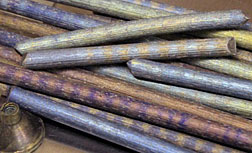- Number 381 |
- February 4, 2013
Ames Lab to lead Critical Materials Innovation Hub

Extruded Europium (Eu) Metal. The colors
arise from various levels of oxidation. The
banding is from surface texture variation
arising from the extrusion process.
Photo by the Materials Preparation Center.
A team led by DOE's Ames Laboratory has been selected to establish a U.S. Department of Energy Energy Innovation Hub that will develop solutions to the domestic shortages of rare earth metals and other materials critical for U.S. energy security. The new research center, which will be named the Critical Materials Institute (CMI), will bring together leading researchers from four Department of Energy national laboratories, academia and the private sector.
The new $120 million CMI will focus on technologies that will enable us to make better use of the materials we have access to as well as eliminate the need for materials that are subject to supply disruptions. These critical materials, including many rare earth elements, are essential for American competitiveness in the clean energy industry. The DOE’s 2011 Critical Materials Strategy reported that supply challenges for five rare earth metals (dysprosium, terbium, europium, neodymium and yttrium) may affect clean energy technology deployment in the coming years.
CMI will leverage these existing research programs into a larger, coordinated effort designed to eliminate materials criticality as an impediment to the commercialization of clean energy technologies. The Hub will address challenges across the entire life cycle of these materials. This ranges from enabling new sources; improving the economics of existing sources; accelerating material development and deployment; more efficient use in manufacturing; recycling and reuse; and developing strategies to assess and address the life cycles of new materials. Cross-cutting research, including developing computational tools and supply chain and economic analyses, will also be necessary to support the basic science needs across all challenge areas.
CMI, headquartered at The Ames Laboratory, will be directed by Alex King, also the director of the Ames Lab. The Hub will bring together some of the most advanced critical material research programs in the U.S. today. Other national labs partnering with Ames include Idaho National Laboratory, Lawrence Livermore National Laboratory, and Oak Ridge National Laboratory. University and research partners include Brown University, the Colorado School of Mines, Purdue University, Rutgers University, University of California-Davis, Iowa State University, and Florida Industrial and Phosphate Research Institute. Industry partners that have joined to help advance CMI developed technologies include General Electric; OLI Systems, Inc.; SpinTek Filtration, Inc.; Advanced Recovery; Cytec, Inc.; Molycorp, Inc.; and Simbol Materials.
“The CMI has built the right team, management, and technical plan and is ready to pursue its mission to eliminate the criticality of materials as a barrier to adopting clean energy technologies,” King said.
[Breehan Gerleman Lucchesi, 515.294.9750,
breehan@ameslab.gov]
